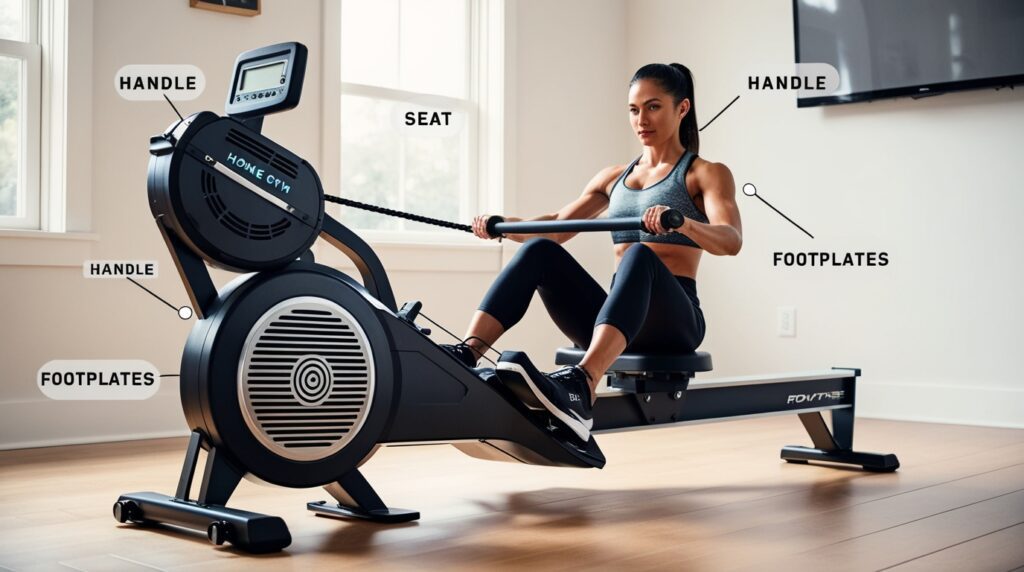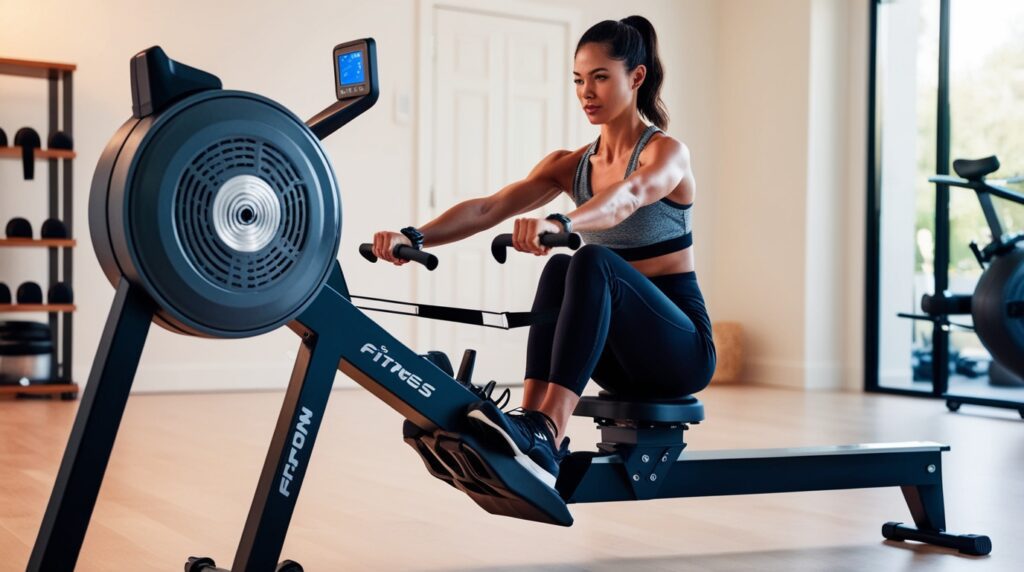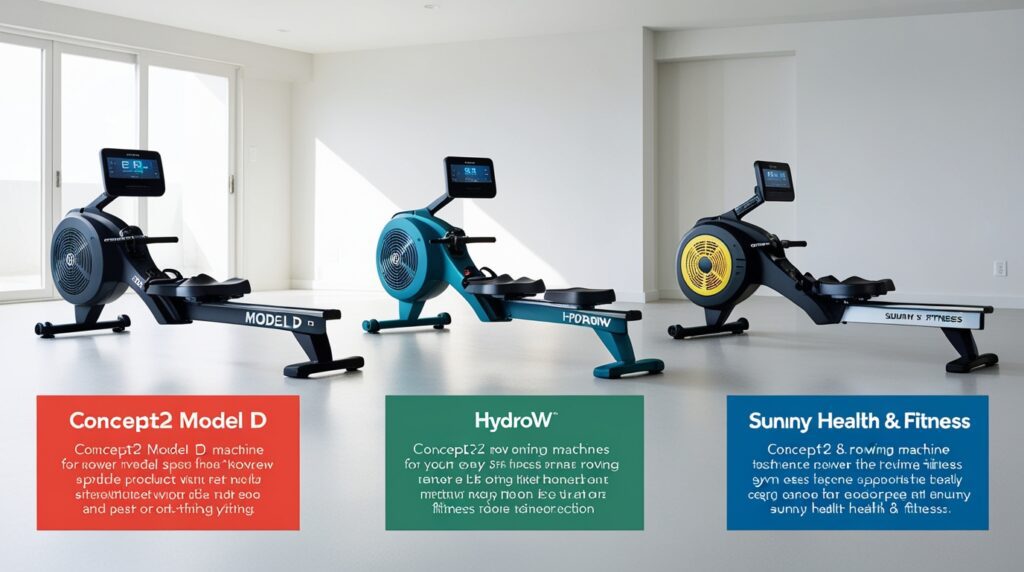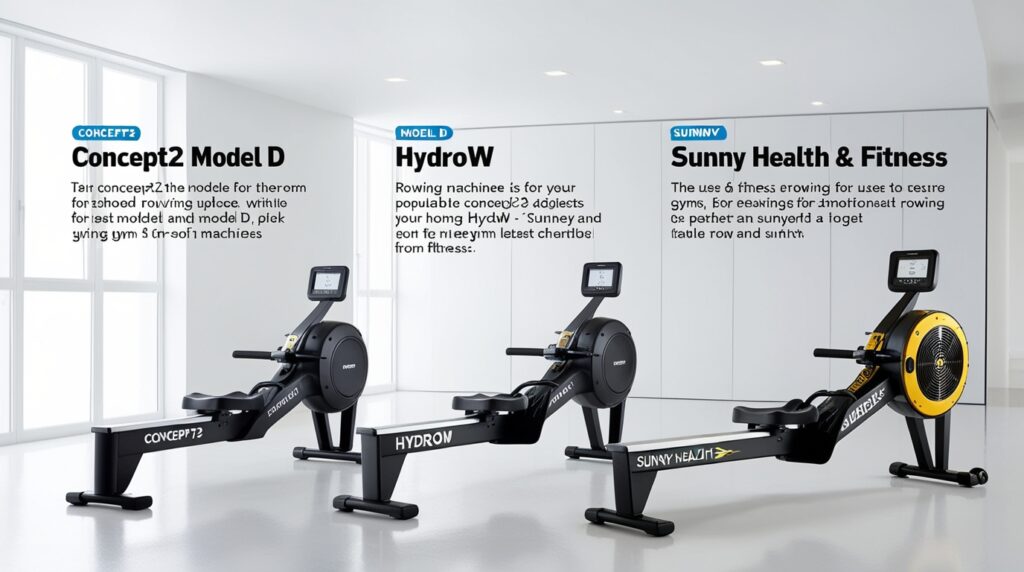If you’re new to the world of fitness or simply looking for an efficient, low-impact workout, rowing machines are an excellent choice to incorporate into your routine. These machines provide a full-body workout, improve cardiovascular health, and build strength without putting too much pressure on your joints. In this guide, we’ll break down everything you need to know as a beginner, from understanding the basics of rowing machines to proper setup, beginner-friendly workouts, and maximizing results. By the end of this guide, you’ll be well-equipped to use a rowing machine confidently and effectively.

Table of Contents
Rowing Machine
1. Understanding the Basics of a Rowing Machine
Rowing machines, often called ergometers or “ergs,” are designed to simulate the action of rowing a boat in water. They offer a total-body workout that engages your legs, core, back, and arms. Let’s break down the basic components of a rowing machine:

- Footplates: These are where you place your feet, often adjustable for different foot sizes.
- Seat: The seat glides back and forth on the rail as you row.
- Handle: Connected to a chain or strap, the handle mimics the rowing oar and is pulled toward your torso during the stroke.
- Display Monitor: This tracks essential metrics like strokes per minute (SPM), distance, time, and calories burned.
- Resistance Mechanism: Rowing machines typically offer air, magnetic, or water resistance. Each type provides a different feel, but all give a smooth, natural rowing motion.
When rowing, the basic movement consists of four stages:

- The Catch: Begin by sitting on the seat with your knees bent and the handle gripped with both hands. Lean slightly forward.
- The Drive: Push through your legs, extend your hips, and pull the handle towards your chest, keeping your back straight.
- The Finish: Your legs should be extended, and the handle should be pulled just below your ribcage with elbows bent.
- The Recovery: Extend your arms forward, lean your torso back to the starting position, and bend your knees to bring yourself back to the catch position.
Understanding this sequence is crucial before jumping into more intense rowing workouts.
2. How to Properly Set Up and Use a Rowing Machine

Proper setup and form are essential for getting the most out of your rowing workouts and preventing injury. Here’s a step-by-step guide to setting up your rowing machine:

2.1 Adjust the Foot Straps
Ensure your feet are securely fastened in the footplates. The strap should go over the ball of your foot, allowing your heel to move slightly as you row. Too loose, and you’ll lose power; too tight, and your movement may feel restricted.

2.2 Set the Damper or Resistance Level
The resistance setting on a rowing machine can be adjusted using the damper (for air rowers) or the resistance dial (for magnetic or water rowers). As a beginner, it’s best to start with a lower resistance to focus on mastering the proper form. A setting between 3-5 on a scale of 10 is usually a good starting point.
2.3 Proper Rowing Form
- Sit Upright: Keep your spine neutral and avoid rounding your back.
- Use Your Legs First: Most of the power in rowing comes from your legs, not your arms. Push through your legs and finish by pulling with your arms.
- Breathe: Inhale during the recovery (when returning to the catch) and exhale during the drive (when pushing and pulling).
2.4 Monitor Your Metrics
Pay attention to the stroke rate (SPM), distance, and pace on the machine’s display. As a beginner, a stroke rate between 22-26 SPM is a good range for longer, steady-state workouts.
3. Beginner Rowing Machine Workouts to Get You Started
Once you’re familiar with the basics, it’s time to try out some beginner-friendly workouts. Rowing workouts can range from steady, moderate-intensity sessions to high-intensity interval training (HIIT). Here are a few sample workouts for beginners:

3.1 10-Minute Steady-State Row
- Goal: To build endurance and get comfortable with the rowing motion.
- Instructions: Row at a moderate pace for 10 minutes, aiming to keep your stroke rate between 22-24 SPM. Focus on smooth, controlled strokes.
3.2 Interval Training (15 Minutes)
- Goal: To build cardiovascular endurance and burn calories quickly.
- Instructions: Alternate between 1 minute of high-intensity rowing (28-30 SPM) and 1 minute of light rowing (18-20 SPM). Repeat for 15 minutes.
3.3 Pyramid Workout (20 Minutes)
- Goal: To improve stamina and increase your speed.
- Instructions: Start with 1 minute of rowing, then rest for 30 seconds. Increase your rowing time by 1 minute until you reach 5 minutes, then work your way back down the pyramid.
These workouts are designed to ease you into rowing while helping you improve your fitness level and build confidence on the machine.
4. Rowing Machine Benefits
Using a rowing machine offers a host of benefits, making it a fantastic option for beginners and seasoned athletes alike. Here are some of the key benefits:
4.1 Full-Body Workout
Unlike other cardio machines that primarily focus on your legs (like treadmills or bikes), rowing engages nearly every muscle group. From your legs pushing off the footplates to your core stabilizing your body, and your arms pulling the handle, rowing provides a comprehensive full-body workout.
4.2 Low-Impact Exercise
Rowing is a low-impact exercise, which means it’s easier on your joints compared to running or jumping. This makes it ideal for people with joint issues or those recovering from injuries, as it delivers an effective cardio workout without added stress on your knees or ankles.
4.3 Cardiovascular Health
Rowing is a great way to improve cardiovascular health. By maintaining a steady pace or incorporating interval training, you can increase your heart rate, improving your overall cardiovascular fitness and stamina.
4.4 Weight Loss and Calorie Burn
Rowing is an excellent tool for burning calories. On average, you can burn anywhere between 300-500 calories in a 30-minute rowing session, depending on the intensity. Since it’s a full-body exercise, it helps with fat loss and muscle toning, making it an effective option for those looking to lose weight.
5. Best Rowing Machine for Home
Choosing the right rowing machine for your home gym can depend on several factors like budget, space, and preferred resistance type. Here are some top options to consider:
5.1 Concept2 Model D

The Concept2 Model D is one of the most popular rowing machines on the market. It features air resistance, which mimics the feel of rowing on water. It’s known for its durability, smooth rowing motion, and easy-to-read performance monitor. This model is perfect for beginners and pros alike.
5.2 Hydrow Rowing Machine

Hydrow is a newer player in the rowing machine market, offering a sleek, high-tech machine with a built-in monitor that streams live and on-demand rowing classes. It uses electromagnetic resistance for a smooth, quiet ride and is great for those who enjoy a more immersive, guided workout experience.
5.3 Sunny Health & Fitness Magnetic Rowing Machine
If you’re looking for a budget-friendly option, the Sunny Health & Fitness Magnetic Rowing Machine is an excellent choice. It offers adjustable magnetic resistance, a simple digital monitor, and a compact design, making it perfect for home gyms with limited space.
6. Tips for Maximizing Your Results as a Rowing Machine Beginner
Here are a few strategies to help you get the most out of your rowing machine workouts:
6.1 Focus on Technique
Proper form is essential for maximizing the benefits of rowing and preventing injury. Even as you increase your workout intensity, always prioritize good posture and smooth strokes.
6.2 Gradually Increase Intensity
As a beginner, start slow and gradually increase your workout duration and intensity. Aim to row for 20-30 minutes at least 3-4 times per week. As your fitness level improves, incorporate more intense interval workouts.
6.3 Track Your Progress
Use the display monitor to track your workouts. Keep an eye on metrics like distance, time, and calories burned. Over time, try to improve your personal bests, whether it’s increasing your rowing speed or rowing for longer durations.
6.4 Incorporate Variety
To keep things interesting, try mixing up your workouts. Incorporate a mix of steady-state rows, interval training, and strength-focused workouts to avoid burnout and continuously challenge your body.
Conclusion
A rowing machine is one of the most versatile and effective tools you can add to your fitness routine, especially as a beginner. By mastering the basics, following proper setup techniques, and incorporating beginner-friendly workouts, you’ll start to see improvements in your strength, endurance, and overall fitness. Stick with it, and you’ll unlock the full potential of the rowing machine, making it a valuable asset in your home gym setup.
Call to Action Ready to take your cardio and full-body workouts to the next level? Start incorporating the rowing machine into your fitness routine today and feel the difference in strength, stamina, and endurance. Whether you’re a beginner or getting back into shape, rowing is low-impact yet highly effective. Need more fitness tips and workout guides? Explore more articles at Starline Healthcare and fuel your journey to a healthier you!
About the Author
V. Murali Krishna is a passionate wellness educator with over 15 years of experience in fitness, yoga, and holistic health. While not a certified coach, his in-depth knowledge and hands-on experience bring practical insights to help readers lead a healthy lifestyle.
Is rowing good for weight loss?
Yes, rowing is excellent for weight loss as it burns a high number of calories while engaging multiple muscle groups. Consistency, combined with a healthy diet, can lead to effective fat loss.
How many minutes should a beginner row?
Beginners can start with 10–15 minutes of rowing, gradually increasing the time as endurance improves. Aim for 3–4 sessions per week to build consistency.
Does rowing help build muscle?
Absolutely. Rowing works the legs, back, arms, and core, helping you build lean muscle while improving cardiovascular health.
Is rowing better than running?
Rowing and running are both effective cardio exercises. However, rowing is low-impact and puts less stress on joints, making it ideal for people with joint concerns.
Can I use a rowing machine every day?
Yes, but beginners should start slowly. Include rest or light activity days to allow muscle recovery and avoid overtraining.
What should I wear while using a rowing machine?
Wear fitted, comfortable workout clothes that allow full range of motion. Avoid loose pants or dangling drawstrings that might get caught.
Do I need to warm up before rowing?
Yes. A quick 5-minute warm-up (dynamic stretches or light cardio) is essential to prepare your muscles and prevent injury.
